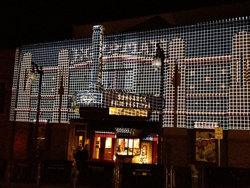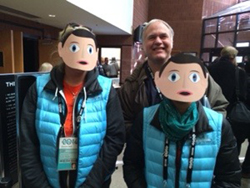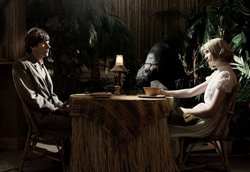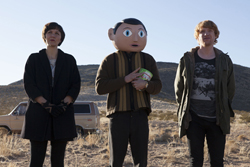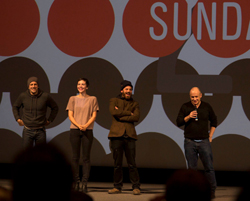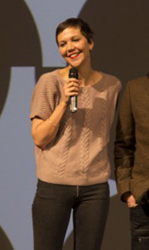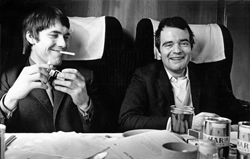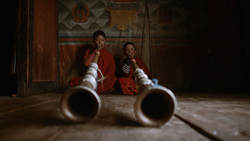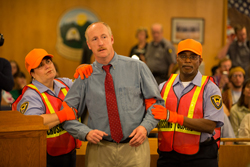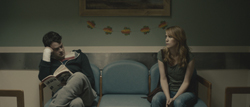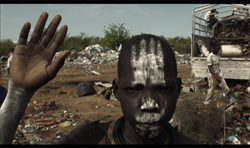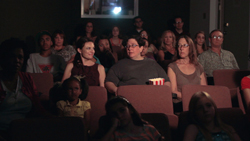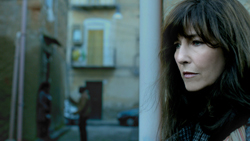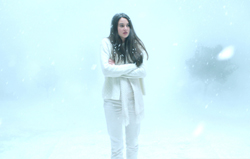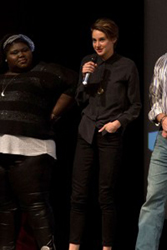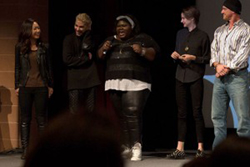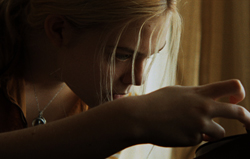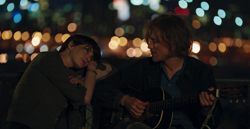Introduction to the Sundance Film Festival 2014
We didn’t take any of the traditional under-the-marquee pictures at the Egyptian theater at Sundance this year because there was this odd display. A calibration grid, projected onto the building. coming from two projectors mounted on the roof of the building across the street. Were they getting ready to project a 3D image of a building, onto a building? No, at some point they did a replay of something that was filmed there the previous summer – a montage of Sundance film titles and characters projected onto this, their most famous theater. This montage was shown before the film screenings at the festival this year.
As in previous years it became just a little more difficult to get tickets. The festival is divided into the first half (A) and the second half (B). As before you enter a lottery to be assigned a time to buy packages, which enables you to enter a lottery, to be assigned a time to select tickets. Simple. In addition to the A and B packages there is a mid-week ‘Discovery Package’. The increased difficulty this year came from further restrictions on what a Discovery Package is eligible to purchase, and more people electing to upgrade their A or B packages for the chance to select their films early (the lottery in this case, is rigged). But, I am less and less concerned about this since it forces us into more offbeat movies. I enjoyed all the movies we saw this year but in many cases that is simply because it was a film at Sundance. Some of them were surprisingly bad. I’ll try to point those out in my reviews below.
Every festival seems to have an unofficial theme or themes. As Secret’s festival photographer Ray Keller noted in his blog there were 21 films about music and/or musicians. We made it to four of those. We also saw four films where duality, a dual identity and good and evil were the theme (‘Calvary’ – two priests, ‘The Double’ – an evil twin, ‘The Skeleton Twins’ – fraternal twins, maybe both are evil in this case and ‘The Voices’ – a schizophrenic struggles against his evil impulses).
We made it to 19 films total this time. Three of those were shorts collections. We might try to scale those back in future years. There are some real gems in these programs. This year, ‘The Immaculate Reception’ was a journey back in time to a recreation of an early 70’s household and family in Pittsburgh, on that fateful football day. My jaw was on the floor watching this movie. But there are many shorts that make us wonder..’why was this one chosen (out of 8000 submissions!!)??’.
Thanks as always to Ray Keller for photos and reviews for Kumiko and Song One. Additional photos are by courtesy of the Sundance Institute.
On to the reviews:
The Double
Based on the book by Fyodor Dostoyevsky which is widely interpreted as a depiction of a journey to madness, this cinematic version could be looked at that way but it also is about identity and what is appropriate action in the world. Director Richard Ayoade, has made one previous feature, ‘Submarine’, and before that he was a comedian. He brings that comedic sense to ‘The Double’. In fact, half way into the movie you might be thinking that it is a comedy. It’s got Wallace Shawn as the office manager, what more could you ask for? But there is a darkness not only about the world depicted here but also the subject. Jesse Eisenberg is once again an incredible lead actor playing both his good self and not-so-good self. He works and lives in a dingy, unforgiving and de-humanizing city. Through the window of his apartment he can see his beautiful and alone co-worker Hannah (Mia Wasikowska). He pursues her but oh-so-slowly. The emergence of his more forthright double shakes things up and begins the downward spiral for Simon.
Frank
The older you get, if you still think about rock music at all, the more you appreciate the difficulty of keeping a band together. This movie opens with the keyboardist from the fictional band Soronprfbs leaving the band by jumping out of their tour van and trying to drown himself in the ocean. Jon, an aspiring musician happens to witness this and is recruited to join the band on the spot. From there he serves as the narrator, a task to which he is well suited since he is the only sane one in this ensemble.
Inspired by the life and performances of Chris Sievey who created the punk band The Freshies and later the comic persona, Frank Sidebottom – who wore a giant papier-mâché head. [IMAGE] The director and music director also sited the band ‘The Residents’ who preferred giant eyeball’s.
Michael Fassbender must be the most fearless actor working today. In the past few years we have seen him as the young Magneto in the X-men series, a sex-addict (Shame), an android (Promethius), a slave owner (12 Years a Slave) and now a musician who constantly wears a giant papier-mâché head. And, he can sing. He sounds a lot like Ian Curtis (Joy Division). And, the movie is very much about the kind of dark, deep creativity that Joy Division exhibited. Where does it come from?
In the Q&A the director said that he wanted to show that the answer is that it comes from an ability to go to or focus on the big picture, to find the larger meaning. He went on to say that it is not the creativity-insanity link that many might think the movie is trying to show. When you see creativity, that is, see actual creation of a song or a movie, there’s a lot of nuts and bolts work to it, not just bolts-from-the blue that only the disturbed can see.
The movie has a beautiful, transcendent, musical, ending that conveys this so well. I want to see it again just for that. It helps that the film follows the two keys to a great movie about music: 1) actors actually playing the music and 2), really good music.
This film is fully integrated with social media. Or, is social media fully integrated in this movie? In place of narration, the lead character tweets his thoughts about what is going on with the band to the band’s followers. The tweets are shown prominently across the screen. This alternate form of narration helped the director replace flashbacks that were present in early drafts of the script. This is great, but, I find the tweet/website text-across-the screen format distracting. And, it looks the same in every movie that does it. Doesn’t matter what I think though, I’m sure we’ll be seeing more of this before we see less of it.
This movie was picked up by Magnolia Pictures, it very much deserves a place on the big screen.
Boyhood
Director Richard Linklater got his start with a distinct focus on young people with ‘Slacker’ and the great ‘Dazed and Confused’. With ‘Boyhood’ he extends that focus over the duration of the youth of a single boy and girl. Filming and developing the script every year for 12 years, Linkater used his own daughter Lorelei as Samantha and Ellar Coltrane as Mason. The script was in place before filming started and amazingly Linklater was able to get IFC to back the project over the entire time. Like many directors, Linklater had the final scene of the movie visualized at the start but the in-between parts took a while.
In the Q&A Linkater said that he sat down to write a movie about childhood but couldn’t picture the one moment to make a movie around and thought, ‘why not have all the moments?’
We see step siblings come and go. Stepdads don’t fare well at all. Patricia Arquette is there for all 12 years as the mother and Ethan Hawke does the same as the father.
Filming started in 2002, Linklater knew that technology would be advancing so he smartly chose 35mm. By the end of the 12 years cameras and labs were starting to fail so they knew it was time to stop. The result is some beautiful footage of Texas in the summer time. Apple computers and certain video games are there as part of the background and will be worth the price of admission for some.
Twelve years of filming add up to almost three hours of movie and it is so worth it.
Lambert and Stamp
A documentary about the managers of The Who. More than managers though, they were often cited as the 5th and 6th members. It’s interesting to note that there is an archetypal pattern for groups of four: the leader, the master, the shaman and the fool. In the case of The Who that would be Roger Daltry (he formed the band and is out front on stage), John Entwistle, Pete Townsend and of course Keith Moon respectively. What role did Lambert and Stamps play then? The answer given in the film – wizards.
More than a film about the Who it is a documentary about the beginning of modern marketing. Long before MTV, Lambert and Stamps knew that the idea was to feed the teenagers back to themselves.
An amazing side note in the film are the incredible stories of class difference. These guys financed the band in part simply by getting an address in the posh part of London (Eaton Place). Having such an address would compel banks to grant you a bank account with 10000 pounds of overdraft ability, no questions asked. Pete Townsend started buying wine in a wine shop – on a tab – they have never asked that it be paid.
Must see movie for fans of The Who, highly recommended for everyone else.
Happiness
Bhutan is the country centered in the Himalayas, famous for their concept of Gross Domestic Happiness. The idea that a country’s success should be measured in the happiness of the people, not their bank accounts. The movie opens with a speech from the King of Bhutan, he first tells the audience that he is eliminating personal income tax. No response. Then he tells them that he is allowing television broadcasting. Wild applause.
To be fair, these people probably don’t have much personal income to tax (that is the point of the ‘Gross Domestic Happiness’ number after all). But what will TV do to that happiness?
It might have worked out better if they put a little thought into what is actually broadcast to the TV’s. There is a lot of incredible scenery in this film and I’ve included many of the stills provided for the film because honestly, the beauty of this country and the photography is reason enough to see this. But the most memorable shots are of families that previously spent the evening by the fire, now watching pro wrestling.
One more complaint, or helpful warning. This film is a re-enactment type of documentary. We see mountain-dwelling Bhutanese, re-enacting some of their actual situations in regard to the arrival of television. We shouldn’t be surprised that these people, never having seen TV, and possibly not even a movie, are entirely incapable of acting. But, their depictions are so far off from the emotions they are stating it can actually be confusing. A woman is reported to be over-the-top angry at her husband for letting their first TV fall off of the mule as he was trying to bring it over the hills to their village. But the re-enacted scene is so flat you can’t really tell what you are watching.
Still, if the scenery in these pictures, or what may be your last chance to see people unaffected by the electronic age are appealing to you I would urge you to seek out this film.
Hits
A film by comedian David Cross. His standup experience made him more-than-able to hold command over the audience at the Q&A afterwards. A good question was asked: ‘Is this a dig at the occupy movement?’ The answer boiled down to “yes, more or less, it’s a dig at both sides” and revealed the mean spiritedness that is sometimes evident in his comedy. And, the misguided notion that the Occupy movement was a waste of time. Mr. Cross probably hasn’t seen ‘99%, the Occupy Wall Street Story’ which was at last year’s festival, but if he had, he could ask himself, if the movement was pointless, why was there a coordinated, top down order to first remove the media from the protest sites and then remove the protestors, on the same day all across the country?
In spite of any possible mean-spriritedness in the movie I would say was fair in its treatment, I don’t see it as talking about Occupy actually. It more has to do with our media obsession and a well-deserved poke at media-jockies. Especially if they are from Brooklyn.
There are more than enough laughs here to make up for some plot lines that were eventually cut from the final film.
The Skeleton Twins
There was a lot of buzz at Sundance over this one. Kristin Wigg and Bill Hader of Saturday Night Live in very dramatic roles. They play the (fraternal) twins that the title mentions. Their family was of the not-so-good variety so they have not been in contact for years and the opening scenes are of a suicide attempted and another stopped only because of getting the news about the first.
The dramatic performances by these two really are striking and the script won the (Waldo Salt) screenwriting award at the festival. The twins are re-united and find a way to glimpse a better future for both of them, together, as only twins can (or should I suppose).
But the script and the director also relies heavily on the comedic and improv abilities that Wigg and Hader bring, and those moments were distracting for me. I suspect that for those few in the audience who haven’t watched SNL recently it wouldn’t be so bad. But, to give an example, at one point we see an almost verbatim recreation of the ‘Gilly’ sketch from SNL that featured exactly these two actors, doing exactly the same thing, changing only ‘Gilly’ to ‘Maggie’. Seriously?
Much of the excessive comedy could be edited out (man aren’t I the curmudgeon?) and I wonder if it will be in the theatrical release. In any case, it’s a thought provoking movie and is worth seeing at some point.
We Are the Giant
The meaning of the title of this film is that the people have the power, not governments or armies. The truth of this statement is evidenced by the responses of the governments of Syria and Bahrain to mass protests of their respective peoples. Peaceful protests in both countries were met with harsh, military, crack downs. If however, the people really are the giant, they are having a hard time dealing with a ‘David’ armed with assault rifles, guns, bombs, gas, and foreign mercenaries who don’t give a sh*t.
In both Syria and Bahrain we see protests met by billy clubs, tear gas and pepper spray just as the Occupy movement encountered in this country. But, and perhaps this would have happened here too, as the protests re-ignite and continue, the governments up their anti to guns. Guns aimed directly at protesters. And they don’t stop.
In the case of Syria then we see the protestors say to themselves, well, they’re just gonna kill us, we happen to have some guns of our own, let’s shoot back. Sounds good until the government gets their bigger guns, and bombs. We’ve heard on the news about the wanton destruction of entire portions of cities in Syria. Here is your chance to see it.
In the case of Bahrain the protestors face the same situation but have so far decided to adhere religiously to a path of non-violence. In the end, the difference so far is that the buildings in Bahrain remain intact while the bodies of those who protest, or would protest, are just as expendable as in Syria. In fact, the police might come to your door and take you away if you’ve been identified as a target.
The film dwells mostly on this choice of non-violence, trying to make the case for it, but they quote Mahatma Gandhi right at the transition in the film from Syria to Bahrain: “Where there is only a choice between cowardice and violence I advise violence”. Given the films continued endorsement of non-violence, I suppose the filmmakers mean for us to interpret Gandhi to mean that it is cowardice to fight back and more courageous to take the beatings. This was indeed the case in the civil rights movement in the US and in India’s fight for independence. In the case of both Syria and Bahrain however, until there is some relief from the relentless slaughter, it doesn’t look like cowardice or courage will make any difference.
I had to reflect on the incredible footage and access to the core of these countries that these documentary filmmakers achieved. They had just put the final film together days before its first showing at the festival and they still had an air of craziness and brush-with-the-devil kind of energy about them at the Q&A. Of course they were driven by the idea that getting this incredible footage out into the world would change things. So far it’s not out-there enough.
We Come as Friends
At one point, as we were making our way from theater to theater we were assaulted by some strange sort of guerrilla marketing by the oil industry. On main street in Park City, a couple of blocks from the famous Egyptian theater, a large sign at street level said ‘4 out of 5 movies at Sundance are powered by oil’. By some amazing coincidence (not!) a man disguised as a photographer jumped into our conversation, saying how the US will be free of foreign oil thanks to fracking for oil and natural gas. “I’m just sayin’… I’m a photographer here..my dad owns an oil company’. Interesting that they think that influencing the minds of movie makers and industry will somehow help to change the culture in their favor. Similar to the tobacco giant Philip Morris funding all manner of indie and alternative arts in lower Manhattan in the 90’s.
Well, any friends the oil industry won by staging this guy on main street were lost if they happened to see ‘We Come as Friends’, a documentary about South Sudan. South Sudan is the country formed in response to the Darfur genocide we were seeing in Sudan in the early to mid 2000’s. Basically the US and its oil companies have taken over the southern part of Sudan while China and its oil companies continue to exploit the northern part. At the border, the Sudanese fight a proxy war with China on our behalf in order to gain a few more wells. The film has some incredible, and awful, close up battlefield footage obtained from the cell phone of a soldier.
This kind of war was exactly the kind of thing that was supposed to be avoided by the forming of South Sudan. The first president of South Sudan and his war minister didn’t get the memo. And, as the film shows, if they had gotten the memo they probably couldn’t read it.
The saddest part of the film though is the treatment of native people who happen to have lived, for unknown numbers of generations, on the land where the US or China wants to set up bases or housing. As bad as it is for those who were in the path of the US, it looks like being in the way of China is far worse.
The Voices
My girlfriend and I have a longstanding joke about the ‘comedies’ available on Netflix streaming: They have to feature serial killers or hit men or at least suicide to be considered comedies. I think there are plenty of actual comedies out there but Netflix isn’t able to afford them for their streaming service so any movie that has a joke in it is fair game for the comedy section.
Netflix can move this one to the top of the list. It is a comedy about a serial killer. Really. It actually is funny though many will have a hard time getting past the gore. Director Marjane Satrapi is known for the wonderful graphic novels and animated feature (‘Persepolis’) about her childhood in Iran and later Europe. With this film she proves that she is a very capable director, animated or live action.
In the Q&A after the showing she acknowledged that the challenge here was to make the audience feel sympathy for the killer and most in the audience (myself included) did so. Your mileage may vary.
Ryan Reynolds plays Jerry Hickfang as well as the voices of his pet cat, pet dog and a couple of other animals that guide him into trouble. What brings the audience along is that he is really trying. He’s been recently released from long term mental care after being committed early in childhood. Taking his prescribed medication moves him from a beautiful existence (where he can talk to animals for instance) to a drab, dark and joyless world. He seems to be doing well enough at work and manages to get a date with a co-worker (played by Gemma Arterton – she played Tamara Drewe in the film of the same name). Even though she stands him up, he ends up giving her a ride when he finds her with her car broke down and if they hadn’t hit that talking deer, well, things might have worked out.
The Foxy Merkins
A ‘merkin’ is a crotch wig. They are not a modern invention but I’ll leave their history till the end of this review because that history has nothing to do with this movie. The Foxy Merkins is the second feature from director Madeleine Olnek, her first was ‘Codependent Lesbian Space Alien Seeks Same’ which played at Sundance in 2011. That title should pretty much tell you all you need to know about The Foxy Merkins.
Margaret is down on her luck and new to New York City. Jo is a self-assured grifter who takes Margaret under her wing. Jo instructs Margaret on how to make money as a lesbian prostitute, starting with picking up middle aged clients (Janes?) by hanging out in front of Talbot’s department store. The film gets a lot of mileage from lesbian situational humor and otherwise has several dangling plot points. For a brief while it suddenly becomes urgent that Margaret find her mother, but then it is dropped when it doesn’t work out. The movie is a funny mixture of super-low-budget and film-history aware-smart. It over-achieves at one moment, with references to male-prostitute buddy movie of the past and then abandoning a plot line with no trace.
The director has a long history as a play-write in NYC and is the author of a well-known book for actors and impressed me with her willingness to go directly at difficult issues with her second short film. ‘Countertransference‘ which played at Sundance in 2011.
A Merkin is a ‘crotch wig’. Wikipedia says the merkin was invented in 1450. Its use was usually associated with venereal disease, women would use it to hide the fact that they had either removed their pubic hair to combat crabs, or mercury, used as a treatment for syphilis, had caused it to fall out.
Calvary
This is by far the most compelling film I saw at Sundance this year. Seasoned film-festival goers know that a movie described as a ‘meditation’ in a festival guide is ‘nap time’. Sundance used the phrase ‘philosophical reflection on faith’ which, had I read it, would have sent me looking for something else to watch. I am so grateful that the difficulty of getting tickets for Sundance films more or less makes the choices for us.
Rather than a ‘philosophical reflection on faith’ I would describe it as a ‘philosophical reflection on faith in the Catholic Church today’. Brendan Gleeson could not have been better as James, a man who came to the priesthood late in life, motivated by a pure and clear desire to serve. His reward for his choice is to be constantly tormented by the small Irish coast-line community that he serves. With more devotion to their various vices and ‘sins’ (as the church would describe them), the citizens of this town see their local Catholic preachers as punching bags (literally and figuratively) and as an ever-ready outlet for their frustrations and anger. Including of course, anger about sexual abuse by the church.
The film is so smart on so many levels, one of the ways is a brilliant peek over the fourth wall on occasion to let the viewer know that the movie is engaged in contemplation along with the audience. This begins with the opening scene when a confessor in the booth sets up the key conflict in the film by saying that he is going to kill James in one week ‘because he has done nothing wrong’. James’ response is ‘Well that is quite the opening line’.
War Story
The amount of un-accounted for violence in movies is staggering. People dying left and right, surviving falls and being run-over or beat up… and that is not even counting the war movies. Here is one that shows some of the consequences of real-world violence, through the eyes and psyche of a war photographer, Lee (Catherine Keener). I was hesitant to reveal even that much in this review as the movie is short on surprises. It is not until we are well into the film that we learn what it is that is making Lee want to hole up in a hotel in Italy, staying away from her family in the States, in spite of troubles of their own. But, the title of the movie is ‘War Story’ after all.
This movie was part of the ‘Next’ category at Sundance, meaning that it is likely filmed or conceived of in such a way as to be outside the mainstream. I don’t know that I would have gone that far in my classification of this film. It certainly is more concerned with having the camera and audience spend time with Keener’s character than anything else, learning and seeing the depth of her disturbance after having witnessed whatever it is that she has witnessed. But it is not what I would call experimental in that regard.
All in all the movie succeeds famously at its goal. Ms. Keener’s strength as an actress has always been an ability to convey inner struggles or questions and she has more opportunity to do so in the movie. This movie is well worth seeing.
White Bird in a Blizzard
The director of this film, Gregg Araki, received high praise from the Sundance festival director at the intro to this movie. About half way through I was really wondering why. ‘White Bird in a Blizzard’ stars Shailene Woodley (‘The Descendents’) as Kat, the teenage daughter of Eve Connor , as played by Eva Green (‘Casino Royale’). The smooth functioning of their suburban household is increasingly disturbed by the actions of the sexually frustrated Eve, all while Kat is experiencing a relationship for the first time. The tension is broken, or redirected, when Eve disappears. Seemingly due to her extreme dissatisfaction with her husband. This would be and should be a good set-up for a film and it presumably works well in the book because it was very well received. But the film is so poorly executed, beating the audience over the head with clues to a mystery that most figured out 45 minutes ago, and with terrible lines for ridiculously clichéd teenage friends, it just made me feel bad for Laura Kasischke, author of the book, who was sitting in the audience.
Low Down
Based on the life of jazz pianist Joe Albany, as told through the eyes of his daughter Amy, as she wrote in her memoir “Low Down: Junk, Jazz, and Other Fairy Tales from Childhood”. This is a supremely crafted film with top-notch acting and direction.
John Hawkes plays Joe as superbly as he has every role we’ve seen him in since his stunning debut in ‘Winter’s Bone’. His daughter Amy is equally moving as played by Elle Fanning. Flea from the Red Hot Chili Peppers plays a fellow jazz musician and is also superb. He was there for the Q&A after the film and remarked at how the story was so close to home for him having also had a jazz musician parent (his step father, Walter Urban Jr.). Flea stressed one of the themes in the movie, that jazz was so dead in the US at least, in the 1970’s that there were many musicians suffering the plight of Joe Albany. They had mastered this incredibly difficult art form but nobody cared.
In the case of Joe Albany one of the consequences of that was heroin addiction and that is the main driver of the film. There have been a lot of biopics in the past few years and to me this one has more to offer than most. Like the short film ‘The Immaculate Reception’ I mentioned above, this movie does a great job recreating the look and feel of its time period (go vinyl!) and has a compelling heart to its story.
Also at the Q&A Flea talked about having grown up in same neighborhood as Amy Albany, claiming to have attempted to pick her up in a grocery store in 1984.
Song One
Anne Hathaway plays Franny, an anthropologist who gets called back from her research in the Moroccan desert when her aspiring musician brother is hit by a car and goes into a coma. Feeling guilty about condemning him for dropping out of college to pursue his musical career, she searches through his belongings trying to piece together the life he led and attempts to find something that will bring him back. One item she finds is a ticket to a concert of James Forester, a famous musician that her brother idolized. She goes to the concert and meets James afterward to give him her brother’s demo CD. She’s surprised when James stops by the hospital to give her brother a private concert. There are sparks between them and a romance begins.
Song One is a glorious journey from loss to love and everywhere in between. Hathaway gives a breathtakingly subtle performance as Franny. The songs performed in the film are composed by Jenny Lewis and Johnathan Rice and are nothing short of amazing. At the Q&A the director, Kate Barker-Froyland stated that when she wrote the script she put something like “and then James plays a song… it is amazing”. She went to Los Angeles to try to find composers for the music and after meeting with Jenny and Johnathan she had a great feeling. She spoke with them about one of the songs needed for the film, then she got on a plane for New York. When she arrived, in her email was a completed song that was perfect for the film. They were hired. The film also showcases Brooklyn, the clubs, restaurants and music scene. It has great performances from Sharon Van Etten and Dan Deacon to name a few. The main flaws of the film are that the music and Brooklyn scenery are relied on to carry parts of the film. If you enjoy both of those, you are in for a treat. If not, it might be a bit slow. Even so, it is a touching story that is well told.
Kumiko; The Treasure Hunter
This film tells the supposedly true story of Kumiko, a Japanese “Office Woman” who tires of making tea for her boss and getting nagged by her mother about promotions and engagements. She fancies herself as a treasure hunter and, when on a trip to a Japanese island, she finds a buried clue in the form of a VHS video tape of… “Fargo”, the 1996 Coen brothers’ film. After many viewings of the film she finds her next clue in a scene where the Steve Buscemi character buries a suitcase full of cash in a snowbank in rural Minnesota. Now with a clear goal, she steals the company credit card and books a trip to Minneapolis in mid-winter to hunt for her treasure. Needless to say, things don’t go so well.
Kumiko is beautifully filmed and the actress, Academy award nominee Rinko Kikuchi (Babel, Pacific Rim) is amazing as the confused Japanese woman. Many people said they liked the film, but the story is a bit weak and drags on way too long.



